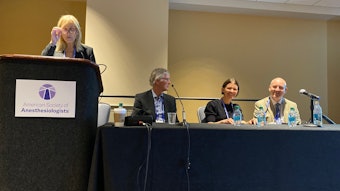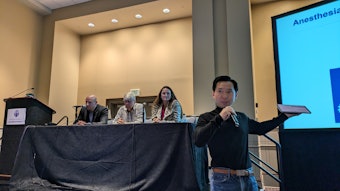Allergy expectations, extremes
Critical perioperative drug reaction considerations.

A spectrum of drug reactions exists within the perioperative setting, from an adverse event to an allergic response, and, from there, full-on, life-threatening anaphylaxis. Jerrold H. Levy, MD, FCCM, Professor of Anesthesiology and Critical Care, and Professor of Surgery (Cardiothoracic) at Duke University School of Medicine in Durham, North Carolina, gave an in-depth history and lecture on the topic.
Although most drugs are too small to be allergic in and of themselves, said Dr. Levy, once they bind to bigger proteins, they can cause an adverse event. This means any drug or product can result in some range of allergy.
Adverse drug reactions can be predictable, such as an overdose, a side effect, or a secondary/indirect response, or unpredictable, such as irrelevant to the drug’s purpose, independent of dose, or association with an immune response, either known or unknown.
“Regardless of cause, from a medical perspective, we need to be able to diagnose anaphylaxis,” Dr. Levy said during the 2024 session, "Anaphylaxis, Allergy, and Adverse Drug Reactions: Perioperative Considerations." “Rapid diagnosis and aggressive therapy are critical to avoid a disastrous outcome.”
Initial symptoms to look for, he said, are difficulty breathing, chest discomfort, sudden malaise, dizziness, and burning, tingling, or itching at the site of injection, orally, or orbitally.
Primary presentations of anaphylaxis are:
- Acute inflammatory response
- Inter-relationships with cardiovascular system, endothelium, and coagulation
- Mast cell/basophil activation by IgE
- Complement activation by IgG
- Non-immunologist mast cell/complement activation
“One of the fascinating but important considerations of anaphylaxis is the mediators that produce vasodilation,” said Dr. Levy, who has researched and authored numerous studies on this subject throughout his career. He said the only way to truly understand what can happen and be prepared is to analyze the available epidemiological data.
Respiratory manifestations include bronchospasm, edema, and high airway pressure. Angioedema is also a common occurrence due to pathological factors, Dr. Levy said, and can affect a patient’s face, tongue, lips, or eyelids as well as larynx, which can lead to respiratory distress.
Bronchospasm, though not the main indication, is the most challenging to treat, he said. Clinical findings show that patients who develop it have a 75% risk of mortality.
In cases of emergent adverse events, clinicians should refer patients for post-reaction allergy testing. In the meantime, the standard schedule of events should be to discontinue the triggering agent, stabilize airway management and confirm high-flow oxygen, administer epinephrine, and support circulation with catechols and I.V. fluids.
Should hypotension persist, he recommended point-of-care ultrasound, 12–24-hour ICU observation to monitor late-phase reactions, and steroid therapy for at least 24 hours.
“Understanding the spectrum of presentation of anaphylaxis is important when evaluating potential reactions,” Dr. Levy said. “Always consider anaphylaxis following drug or blood administration or any procedural interventions.”











